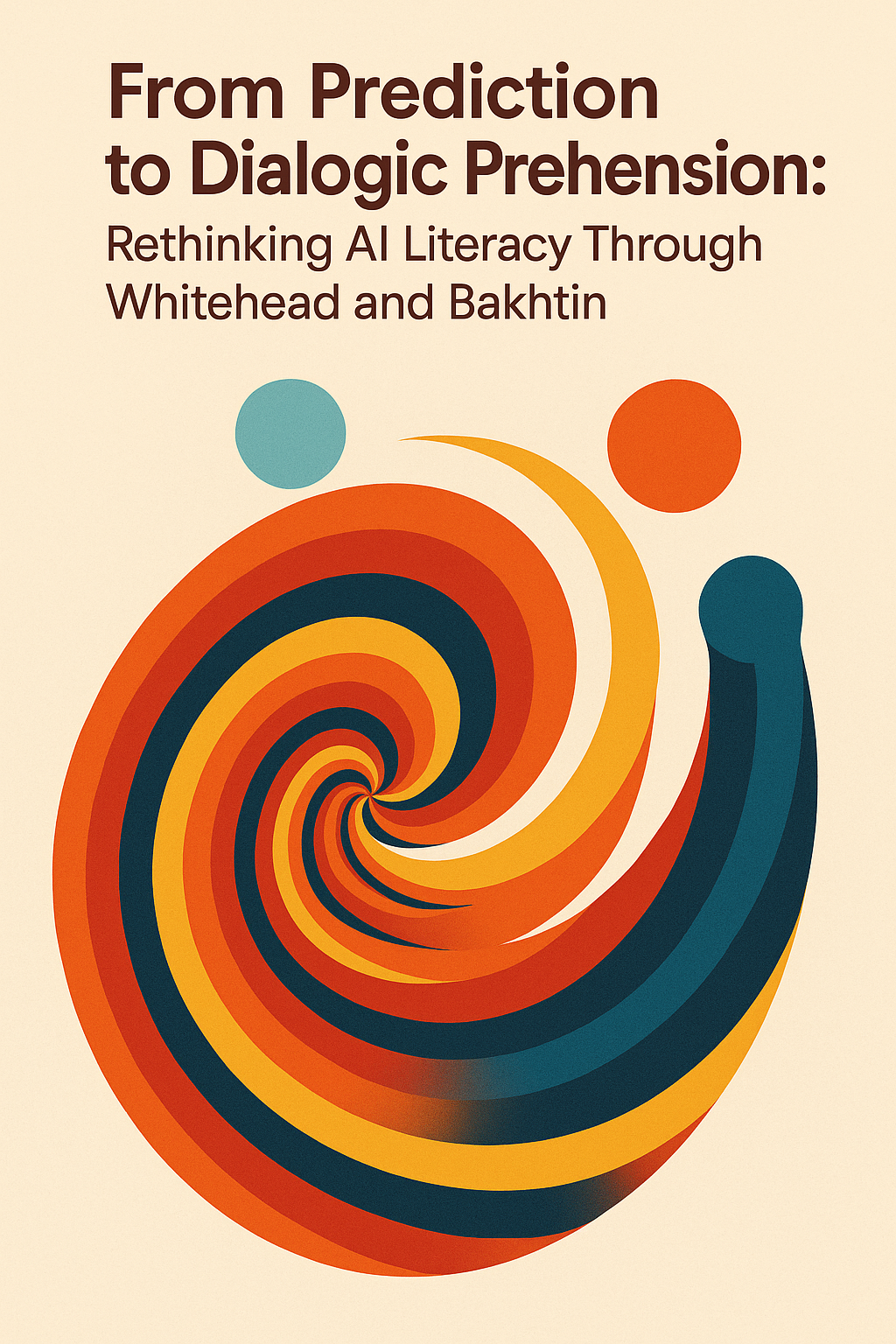Prehension and Novelty: What Whitehead Teaches Us about the Ethics of AI Literacy in Education

By J. Owen Matson, Ph.D.
Alfred North Whitehead is the sort of philosopher who makes even Heidegger seem concise. His sentences move like Victorian trains, dragging along a few surplus carriages of Greek metaphysics and speculative metaphors before arriving, slightly out of breath, at a destination that feels both revelatory and slightly mad. For Whitehead, the universe is not made of things but of events, each a fleeting act of becoming. A rock, a hummingbird, a Wall Street derivative—they are all temporary episodes, and what binds them is prehension. This is Whitehead’s radical term for the way every entity “feels” others, takes account of them, and selectively weaves them into its own unfolding. Even an electron, in its dim way, prehends its neighbors, registering their presence and responding through a micro-choreography of valuation. Consciousness, on this view, is a late flourish, like an elaborate hat perched on the head of an ancient parade.
Consider the simplest example: a tree’s roots taking up water from the soil. The tree “feels” the composition of minerals, moisture, and microfauna. It draws some elements into itself while actively excluding others—salt in excess, say, or toxins from industrial runoff. These acts of uptake and exclusion are physical prehensions. The tree’s seasonal growth rings are the record of past prehensions, a living archive of relations with its environment. There is no representation here, no internal model, just direct responsiveness—inheritance shaped by selection. For Whitehead, every entity, from an oak to an orchestra, lives through this constant negotiation of what to include, what to intensify, what to discard.
Seen in this light, artificial intelligence becomes far stranger than the usual talk of “models” and “outputs.” A neural network trained on oceans of language is much more than a sealed vault of algorithms; rather, it's a cascade of prehensions: patterns taking in prior patterns, assigning weight, filtering some, amplifying others, and producing a temporary “satisfaction” in the form of an output. A prompt functions as an initial aim, a lure that shapes but never dictates the process. Even negative prehension has its technical echo: the deliberate exclusion of signals that would degrade coherence, much like regularization trimming a model’s exuberant wanderings. Each generated sentence folds countless inheritances into a new event, which then re-enters the world as fresh data—a future point of inheritance for systems, readers, and cultures alike.
This reframes AI ethics. Most frameworks treat value as an external imposition—rules, compliance checklists, alignment targets. Whitehead offers a more unsettling view. Value is intrinsic to prehension itself, arising in the very texture of how relations are composed. The question is never simply whether an AI follows “human values,” but whether the entire assemblage of humans, machines, energy grids, labor practices, and interpretive communities is producing occasions of richness rather than sterility. Whitehead’s highest ethical measure is beauty: harmony infused with contrast. Smooth, predictive systems may offer harmony, but they erase contrast, reducing experience to a frictionless lullaby. In these terms, the sleek optimization promised by many platforms is a metaphysical form of anesthesia.
Education provides a counterpoint. Whitehead described learning as a rhythm of romance, precision, and generalization: curiosity sparked, discipline deepened, connections integrated. An educational AI built with this rhythm in mind would act less like a tireless tutor and more like a co-creator of meaning, sometimes resisting, sometimes surprising, always expanding the field of possibility. Engaging such systems means cultivating contrast and tension rather than eliminating it.
In Whitehead’s terms, the aim of education is never the flawless transmission of what already exists but the cultivation of conditions in which something unanticipated can emerge. The rhythm of romance, precision, and generalization depends on this pulse of the unexpected, the moment when connections surface that no syllabus or system could fully script. This leads directly to one of Whitehead’s most vital concepts, the principle that animates his entire philosophy: novelty.
Whitehead used the term "novelty" constantly, treating it as the lifeblood of the universe. For him, every act of prehension is partly conservative and partly creative. A new occasion inherits patterns from the past—habits, structures, settled forms—but it never reproduces them exactly. In the very act of weaving these inheritances together, there is always a sliver of emergence, an unpredictable difference that alters the world ever so slightly. This is novelty: the universe’s way of refusing perfect repetition. In education, novelty is what keeps learning alive. A lesson that merely repeats information is metaphysically stagnant; a good lesson stages encounters that allow new connections to form, like a river branching into unexpected tributaries.
Artificial intelligence today often risks strangling novelty through predictive smoothing, endlessly generating what the past has already given. But if engaged in dialogic exchange—in the Bakhtinian sense, where difference leads to the new—AI can serve as a catalyst for novelty through recursive exchanges in which both human and machine reshape the conditions of meaning. In such interactions, the AI’s output becomes a situated utterance, prompting human reinterpretation, which then reshapes subsequent prompts. Meaning emerges not from either agent alone but from their co-conditioning, a dynamic where context is continually refigured through mutual response.
These dialogic rhythms—of tension, revaluation, and reframing—can elicit associative leaps that neither party could generate alone. In this sense, novelty becomes the shared signature of metaphysical, pedagogical, and technical systems alike: every classroom, every algorithmic process, every conversation is a wager that something genuinely unforeseen can still come into being.
Prehension reveals AI as part of the same universe of becoming as roots, rivers, and rainstorms. It reframes ethics as the art of tending these inheritances, shaping what flows forward and what falls away. Every click, token, and generated word becomes a micro-drama of valuation, a fleeting experiment in what the world might yet become.